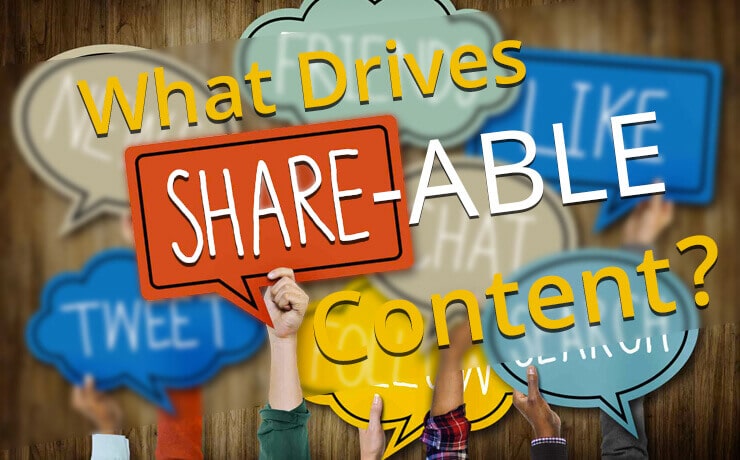What Drives Shareable Content?

Chad Faith
Director of Content

We are all willing to share posts that seem to be worth our attention or useful in social networks. But we rarely think about why we do it. What motivates us to share this information with our online friends? The answer to this question can provide a deeper insight in those inward incentives that make us share.
If you own a website and understand the importance of marketing in social networks, you may naturally want to understand the mechanisms for creating viral content in order to achieve the desired growth of popularity. Let’s consider these mechanisms so that you could easily create content that will bring you success in social networks.
If you are ready for some research, let’s go ahead!
Psychological Aspect – Which Emotions Drive Sharing?
New researches reveal that information which evokes certain emotional reactions and has undeniable impression is almost inevitably shared. Psychologists call this behavioral pattern Pleasure-Arousal-Dominance emotional state model. It explains that the emotional cluster provoked by certain event or information can be estimated on the three following scales:
Pleasure scale. This scale shows the level of positive emotions evoked by a piece of information. Emotions/states of happiness, admiration, and satisfaction would undeniably be placed at pleasure end of the scale, while distress, grief and sadness fall to the displeasure end.
Arousal scale measures the strength of emotional response to a piece of information and intensity of motivation to undertake some actions as a reaction to these emotions. For example, rage or grief will have a low ranking on the pleasure scale. But evidently rage is indicated as a high arousal state (it drives people to destructive actions in order to achieve some kind of relief), while grief is a low arousal state (it may call for seclusion and deep self-contemplation).
Dominance scale indicates the level of control over certain situations. Positive emotions tend to be dominant, while negative emotions such as fear or anger have a low ranking on dominance scale (if a person fears something, he/she is unable to exercise much control in a dangerous situation).
Modern research on social sharing reveals that the most successful combination of emotions to make an article shareable is High Pleasure, High Arousal and High Dominance. So now it may seem that the secret has been disclosed. But to create the content that evokes such an emotional response is not an easy task. For example, your content ought to be a kind of insight (high arousal) which may help to change somebody’s life for better (high pleasure) and this change will come around after this person puts some effort to it (high dominance).
High Pleasure, High Arousal and High Dominance are the drivers behind people’s urge to click the link which they very likely suspect to be a click-bait that is normally spammy. Still when people see something like “You will look like a model in a month without tiresome workout by just using our product” they are eager to learn such easy way to success that they can introduce into their lives to gain the much-wanted result. But for your website, you don’t want such kind of promises. It is worth remembering that your article should affect people in such a way that makes them feel a surge of positive energy which can help them feel able of achieving a positive change. If your content is truly impressive and inspiring then people are only happy to share it.
To imbue your articles with positive energy, it is strongly advisable to use inspiring imagery such as depiction of confident, friendly and attractive people and spectacular scenery. Keep in mind that your imagery should look genuine: staged stock photos are often pretentious and evoke much lesser emotional reaction than shots of real people in natural situations with unfeigned emotions.

Social Approval as a Sharing Driver
Actually, social networks may cause a kind of addiction not only as means of communication but as an instrument for earning social approval. When we get ‘likes’, we receive the approval of our friends and acquaintances and thus comprehend that we’re doing right things while living a worthy life. The same holds in relation to shared content: we repost articles and photos to acquaint people with it and to earn their gratitude for sharing this content with them through ‘likes’ and ‘reposts’. So, when we share content, we inevitably think about our audience in social networks and yearn to generate value for it.
Researches have shown, that people feel incentive to generate value for others by sharing content, and prefer to share content that has already been shared a number of times to the content yet unshared. This mechanism functions as a means of social validation that states: ‘Some people believed this article to be useful and shared it’. This increases the value of such an article. The same mechanism works with a crap video that received 1 million views on YouTube: many would believe that only this 1 million of views makes it a worthy piece of content for certain.
Takeaway. Yet it is not advisable to concoct overmuch with ‘likes’ and ‘shares’ of your content. You should however ascertain that there are discernible social sharing buttons beside your article (no one will be happy to spend time searching for them). And you’d better choose buttons which have counters showing the number of ‘likes’ and ‘shares’ received by your content. In this case various social sharing extensions can be useful. For example, if you have a WordPress website, try to find some popular solutions for social sharing on the plugin market, so that you’ll certainly be able to receive more ‘shares’ with up-to-date and easily comprehensible sharing interface.

Consider how the buttons for social sharing are used in this fashion WordPress theme by TemplateMonster. Quite discernible social buttons widget hovers on the left and keeps the same position when users scroll down the page. Thus, to share the content users don’t need to scroll down to the end of the article (or return to top). If you pay attention to your social sharing buttons’ usability as exemplified here, you’ll get your articles shared in the twinkling of an eye.
Top 5 Drivers of Content Sharing
Having learned what emotions and social factors launch content sharing, you should discover what constituents of success will bring you benefits. Let’s consider the main factors making your content shareable:
Entertainment-factor. Write your article as if for fun – an easy read while enjoying a cup of tea or coffee and people will readily share such a pleasure with others. You shouldn’t be too serious or tedious: it is not a scientific research or a novel for Nobel prize. Whatever is your topic, combine informative passages with sheer entertaining twists and don’t forget to add a bit of humour. Remember that you’re writing not just for the writing’s sake, but with the aim to create a comprehensible piece of information that can be easily read to the end.
Practical value. Since you’re not writing a novel, people won’t read it just for aesthetic pleasure. Your article should bring your audience some practical value and provide a ready-to-use advise that your readers may in some way implement in their lives. To achieve this always keep in mind your target audience and their demands and inclinations. Discuss important issues and sum up your writing with a bulleted list of ready-to-use tips/ directives which may help to undertake the actions that your article relates to.
Sharing for self-expression. People are inclined to share information about most vital and topical for them issues. An article shared by a person is a kind of reflection of his/her personality and informs other people about this person’s interests, preferences and convictions. Thus again conclusion here is that understanding of your target audience, its cares and beliefs, is of great importance for achieving genuine popularity of your content.
Giving incentives. One more way to increase content sharing is providing incentives for ‘shares’. It’s very likely that the mechanism is familiar to you. Here it is: ‘Share this content in such and such social networks and you will get a discount for our new product’. Other incentives can be a present for the most active sharer or access to unique content. Incentives are undoubtedly found to be effective in encouraging content sharing, but be careful with them as the excessive exploitation of incentives may lead to the situation when no one cares about your content, but only about incentives.
Visual design and aesthetics of presentation. The manner of your content presentation influences content sharing in the most crucial way. Visual presentation demands your closest attention: give heed to visual structure, correlation of titles and subtitles, tags, imagery and video that promote your article’s message. Never forget that many articles get shared because they represent information in striking and eye-catching ways (infographics, interactive schemes, animated graphs and diagrams, etc.) Pay due attention to the aesthetics of content presentation and this will be repaid a hundredfold in increased shares.

As shown above, creating a shared-worthy content is easier, then it seems. In order to create viral content, never forget about the emotions your content evokes. Your articles should stimulate, arouse, inspire and truly appeal to your target audience. Balance fun and entertainment with meaningful information and practical value, take into consideration logical structure and visual design of your article, provide incentives to active sharers and pay the closest attention to usability of your website’s social sharing buttons. By following this simple advice, you may become a social marketing professional, whose content spreads universally and opens new horizons for you!
Image credits: www.matrixwebagency.com, www.templatemonster.com.
Post contributed by TemplateMonster.
 Free
Consultation
Free
Consultation Free
Google Ads Audit
Free
Google Ads Audit







